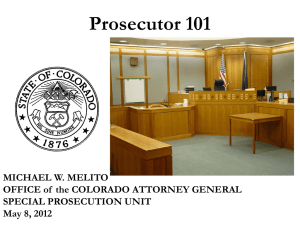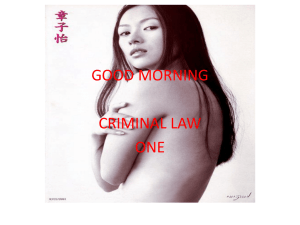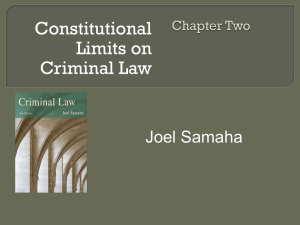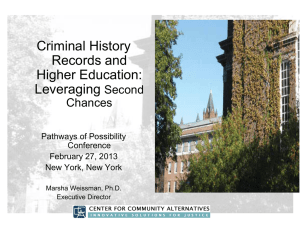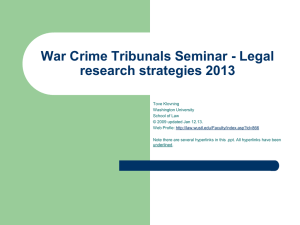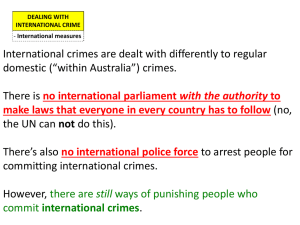Chapter 1
advertisement
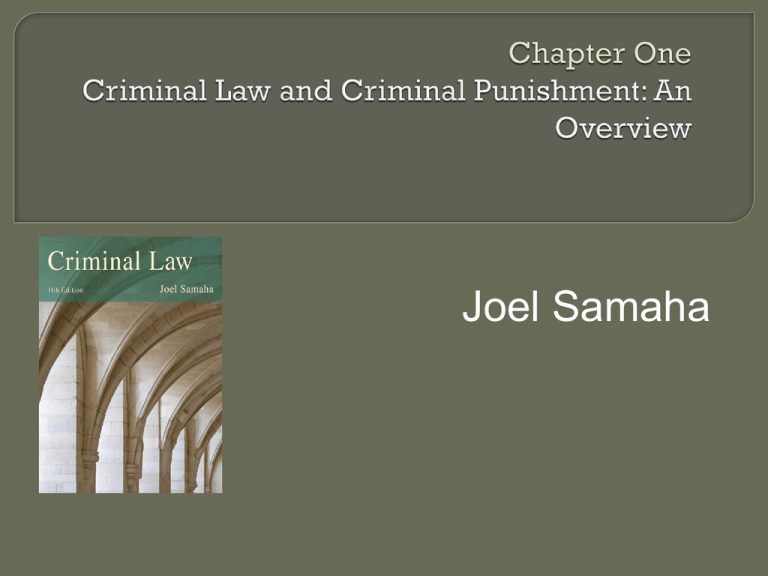
Joel Samaha To define and understand what behavior deserves criminal punishment. To understand and appreciate the relationship between the general and special parts of criminal law. To identify, describe, and understand the main sources of criminal law. To define criminal punishment, to know the difference between criminal and non-criminal sanctions, and to understand the purposes of each. To define and appreciate the significance of the presumption of innocence and burden of proof as they relate to criminal liability. To understand the role of informal discretion and appreciate its relationship to formal criminal law. To understand the text-case method and how to apply it to the study of criminal law. Not all behavior that is wrong is criminal behavior Criminal liability should be imposed only if the wrong was a crime Criminal liability is reserved for behavior that unjustifiably and inexcusably inflicts or threatens harm (to another, to society in general) Torts are private actions against a private citizen, a corporation, or another private citizen (not the government, the way crimes are prosecuted) Person bringing the action is called plaintiff Person being sued is the defendant Jury/Judge will determine if the defendant is responsible (“guilty” or “not guilty”) If person is found responsible, the remedy will be monetary (general damages, punitive damages) Often have the same names as crimes, and can be very similar “State” (people of the state) brings the action against a criminal defendant If defendant is found “guilty” then he or she is “blameworthy” and worthy of societal condemnation If guilty, then the defendant can be punished by death, incarceration, fines, community service, etc… and not just monetary damages Guilt, though, must be found beyond a reasonable doubt Facts: Chaney, the defendant, was found guilty of forcible rape and robbery. The trial judge gave the defendant only 1 year concurrent sentence and possibility of parole with the discretion of the parole committee. Now the state appeals and argues that this sentence was too light. Issue: Was the trail judge too lenient? Holding: Yes. The court stated that the crime the defendant committed was serious and he should have gotten a longer sentence. Facts: Pete, the defendant, was sentenced to 2 one-year consecutive sentences, for a guilty verdict of 2 counts of unlawful sale of intoxicating liquor. Issue: Was the sentence too excessive? Holding: Yes. The court stated the sentence was too excessive as the two offenses were really part of one general transaction. Mala in se crimesbehavior that is inherently wrong or evil Mala prohibita offenses are behaviors that are criminal only because there is a statute or ordinance that says it is Felonies: crimes punishable by death or confinement for a specific period of time or more (usually one year) and fine Misdemeanors: crimes that are punishable by a fine and or confinement in local jail (generally up to one year) Is it a Felony or Misdemeanor?? Read the following scenarios and determine what level of offense was committed. A 20 year-old male was sentenced to prison for 15 months. What level offense did he commit? A 36 year-old female was released from jail after serving her entire 280 day sentence. What level offense did she commit? A 27 year-old female appeared before the court and was informed if convicted of the offense she has been charged with, she could serve no more than 365 days in jail if convicted. What level offense did she commit? A 45 year-old male was released from custody after serving a 48 month sentence. What level offense did he commit? A 55 year-old male was ordered to pay a fine of $300.00. If he does not pay, he will have to serve 90 days in jail. What level offense did he commit? GENERAL PART OF CRIMINAL LAW: the general principles that apply to more than one crime Complicity • Accomplices • Accessories Inchoate Offenses • Attempt • Conspiracy • Solicitation SPECIAL PART OF CRIMINAL LAW: defines specific crimes and arranges them into groups according to subject matter Categories of crimes • Crimes against persons examples • Crimes against property examples • Crimes against public order and morals examples • Crimes against the state examples Codes • • • Common Law • • • State codes (State legislative assemblies) Federal Codes (U.S. Congress) Local ordinances (Municipal legislative bodies) Common law originally came from English judges, and was passed to a degree to the colonies and to the states State common law Federal common law U.S. v. Hudson and Goodwin- no fed. common law, BUT Judicial common criminal law making? Municipal Ordinances • Local governments have broad power • Can duplicate, overlap with state codes, and when in conflict, the state codes are supposed to trump municipal ordinances Administrative Crimes • Agency made law (rapidly growing source of crim law) Case Law • Judge made law—interpretations of codes, common law, ordinances, administrative law • Judicial criminal law making Issues of retroactive law making (NOT a violation of ex post facto) Judicial activism challenges • Stare decisis and precedent Trend from common law crimes at beginning of our nation to predominantly codes Model Penal Code (MPC) • • • • • ALI Final version 1962 Followed by most, but not all states No state has adopted MPC in its entirety Common denominator of American Criminal Law Criminal Offense or Municipal Ordinance? Read the following scenarios and determine whether the act would be a Criminal Offense or violation of a Municipal Ordinance A teenage boy was found in the park at 11:15 pm. City curfew is 11:00 pm. An elderly woman intentionally exits a retail store pushing a cart containing shoes, groceries, cleaning supplies and a tv without paying for the items. An adult female is walking down the street with an open container of alcohol. While backing out of a parking spot, an adult male hits and severely injures the child exiting the vehicle next to him. It was determined the adult male was under the influence of an illegal substance 50 autonomous and independent states • Each has own code. Washington, D.C. (own Federal Criminal Law (U.S. Codes) Thus, 52 States criminal code) criminal codes within the U.S. have broad law making authority Federal government has limited law making authority (only crimes related to national interest) Punishment defined: inflicting pain or other unpleasant consequence on another person Criminal Punishment criteria • Inflict pain or other unpleasant consequence • Prescribe a punishment in the same law defining the crime • Must be administered intentionally • State must administer them Incarceration: • “quantity” of punishment doesn’t tell us much about the three aspects of punishment (definition, purposes, limits • Rates of incarceration: (number of prisoners per 100,000 people) • U.S. is the leader of incarceration (highest rate) • Unequal representation of gender, age, race in prison population RETRIBUTION punishment justifies itself, pain of punishment pays for offenders’ crimes Eye for an Eye Looks to past crimes and punishes individuals because it is right to hurt them Punishment benefits criminals PREVENTION • Pay back society by accepting responsibility through punishment. Assumes free will • Individual autonomy Accords with human nature to hate wrongdoers Rests upon two philosophical foundations: culpability and justice pain of punishment brings greater good of reducing future crime Punishment looks forward and inflicts pain to prevent future crimes Four types of prevention • General Deterrence • Special Deterrence • Incapacitation • Rehabilitation Difficult to translate abstract justice into concrete penalties Retaliation is NOT part of human nature in civilized society (barbaric) Free will justification is undermined—forces beyond human control determine individual behavior Vast majority of crimes don’t require culpability to qualify for criminal punishment • Crimes without moral turpitude • Crimes against public order and morals • Unintentional homicides Punish the offender to make an example of them and thereby deter others from committing future crimes Jeremy Bentham –deterrence theory • Rationalism- Individuals maximize pleasure and minimize pain. Humans won’t commit crimes if: Pain of punishment outweighs Pleasure gained from committing crime • Hedonism—if prospective criminals fear future punishment more than they derive pleasure, they won’t commit crime Rational human beings won’t commit crimes if they know the pain of punishment outweighs the pleasure gained from committing crimes Least amount of pain needed to deter the crime should be permitted Emotionalism surrounding punishment impairs objectivity Prescribed penalties rest on faith Rational free-will that is underlying deterrence theory does not exist…complex forces within human organism and external environment influence behavior Behavior is too unpredictable to reduce to mechanistic formula Threats of punishment don’t affect all crimes or criminals equally Deterrence is unjust because it punishes for sake of example • Punishments should not be a sacrifice to the common good Punishing convicted offenders to deter THEM from committing any more crimes in the future Preventing future crime by making it physically impossible for the offender to harm society at large • Incarceration: locking people up so they cannot harm society • Altering surgically (or chemically) an offender to make them incapable of committing their crime • Executing a person Criticisms of Incapacitation: Incarceration shifts criminality from outside prison to inside prison Violent offenders continue offending in prison, property offenders continue also (ex: trading contraband) Incarceration is generally temporary Rehabilitation is preventing crime by changing the personality of the offender so that he will conform to the dictate of law (Herbert Packer) Medical Model of Criminal Law - crime is disease, offenders are sick Purpose of punishment is to treat criminals Incarceration as rehabilitation- length depends on how long it takes to cure the offender REHABILITATION ASSUMPTIONS: Determinism CRITICISM OF REHABILITATION: • Forces beyond offenders’ control cause them to commit crimes • No choice made by offender • Can’t blame offender Therapy by experts can change offenders Rehabilitation is based on faulty, unproven assumptions • Causes of crime complex • Human behavior not well understood • Sound policy can’t depend on treatment Makes no sense to brand everyone who violates the law as sick and needing treatment Inhumane, cure justifies large “doses” of pain All four punishment justifications have been supported at different times Weight given to each has shifted over centuries Rehabilitation philosophy justified indeterminate sentencing laws of the 1960s Retribution and incapacitation philosophy justified fixed, mandatory sentences since 1980s Presumption of innocence means that the state has burden of proving that the defendant committed the crime Burden of proof • Burden of production: requirement that party present some evidence to support their claim • Burden of persuasion: requirement that the party persuade the jury (or judge) to a certain “standard of proof” Standard of Proof—level of certainty to which the jury (or judge) needs to be persuaded • Beyond a reasonable doubt – criminal liability (highest standard in law) • Preponderance of the evidence – civil cases and some criminal defenses Bench Trials-the accused give up their right to a jury trial and are tried by judges who decide whether prosecutors have proved their guilt Corpus Delicti- Latin for “body of the crime,” it refers to the body of the victim in homicides and to the elements of the crime in other offenses Review the website below regarding the verdict in the Casey Anthony murder trial http://www.youtube.com/watch?feature=endscreen&NR=1&v=mE7_P7 N-lhE Considering what you have learned about the burden on proof, discuss why you think the jury found Casey Anthony not guilty of murder? Why do you think the jury found her guilty of giving false information to the police? Affirmative Defenses—switch the burden of production from the state (which always maintains the ultimate burden of proof) to the defendant Defendant must present some evidence to support affirmative defense Some states require defendant to also carry burden of persuasion to preponderance, other states keep the burden of persuasion on the states (regarding the defense) Every stage of the criminal justice system is a decision making point Criminal Justice professionals make decisions based upon training, experience, and unwritten rules Discretion is exercised, hopefully, in accord within the law Discretion should be exercised in a way that justice and fairness are not jeopardized Importance of case law—real life examples Application of principles and definitions of various crimes throughout the text Excerpts are edited versions of appellate court decisions—not trial transcripts Excerpts are not from cases where defendant was acquitted (state cannot appeal a verdict of not guilty in a criminal case) Trial Court-where criminal cases start Not guilty verdict—jury determined that the state did not prove its case beyond a reasonable doubt Guilty verdict—jury determined that the state proved its case beyond a reasonable doubt Innocent verdict—there is no such term used in criminal law. Jury is only to decide legal guilt or no legal guilt. It is not making a pronouncement of factual innocence Acquittal – result of the jury rendering a “not guilty verdict” Conviction—result of the jury rendering a “guilty” verdict, coupled with the imposition of sentence Review the website below to learn more about the Supreme Court http://www.supremecourt.gov/about/briefoverview.aspx How many justices serve on the Court? Who is the current Chief Justice of the Court? The Supreme Court interprets law to determine if any constitutional rights were violated. How do you think the internet, facebook and other social media have impacted the type of cases the supreme court may rule on? Title Citation Procedural History Judge Facts Judgment/Decision Opinion The Opinion contains two essential ingredients: Court’s Holding-legal rule the court has applied to the facts of the case Court’s Reasoningreasons the court gives to support its holding Opinion • • • • Majority opinion Dissenting opinion Concurring opinion Plurality opinion Distinguish between case or legal brief and the appellate brief Case/Legal brief—tool to help students focus on the main facts and issues dealt with in the opinion of the court Appellate brief– the supporting documentation for a criminal appeal, outlining and arguing to the judges why the court should rule in defendant’s favor. Points out all the legal “errors” that occurred in the trial What are the facts • Defendant’s actions • Government actions? (very important in criminal procedure cases, less so perhaps in criminal law) • What is the controlling law, statute (very important in criminal law—what are the elements of the crime the state had to prove?) What What is the legal issue are the arguments in the court’s opinion What is the judgment of the court (affirm, reverse, etc) State v. Metzger = case name 319 N.W. 2d 459 (Neb 1982)= full case citation 319 = volume of the reporter N.W.2d = the reporter in which the case opinion was published….there are official and proprietary reporters 459 = page number the case begins on (Neb 1982) = State where the case took place, and the year of the decision

